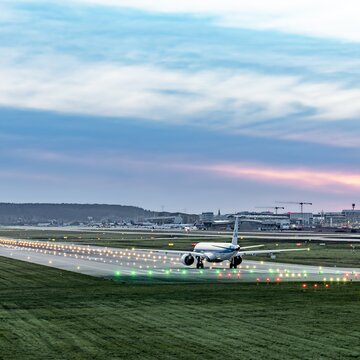Energy and climate master plan

- Stuttgart Airport wants to reduce almost 100 % of its direct CO2-emissions through its own efforts.
- Biggest lever: energy-efficient refurbishment of the terminals
- STR solar airport: the electricity yield from photovoltaics is set to increase tenfold by 2040.
- Smart grids essential for success: making optimum use of electricity with battery storage systems
- Stuttgart Airport supports the energy and mobility transition in the country.
- Acceleratingclimate-friendly flying: The STR accompanies technological progress.
Zero emissions from 2040

2024, CO2eq = CO2 equivalents

Almost complete CO2-reduction by 2040
From 2040, Flughafen Stuttgart GmbH aims to operate STR on a net greenhouse gas neutral basis. In order to achieve this, Stuttgart Airport has developed a scientifically based reduction plan for its directCO2 emissions in a long-term process. The Energy and Climate Master Plan demonstrates that Stuttgart Airport can reduce almost 100 percent of its direct greenhouse gas emissions on its own - by taking measures on site.
Only a small fraction - the unavoidable direct emissions - remains. The airport will neutralize this. This means that the same amount ofCO2 will be removed from the atmosphere.
In its master plan, the airport company considers all emissions from the electricity and heat supply of its infrastructure and buildings as well as ground traffic at the entire site up to 2040. Among other things, the program envisages covering almost all of the airport's future requirements with renewable energies - both through its own production of solar power and through purchases. The electricity yield from photovoltaics is to be increased more than tenfold by 2040. In order for Stuttgart Airport to achieve its net-zero target, it will also invest in the expansion of intelligent energy systems (smart grids) and use state-of-the-art technology, such as more powerful photovoltaic systems and electricity storage systems.
The Fraunhofer Institute for Solar Energy Systems provided advice and support in the development of the master plan. Using a simulation tool, the airport can react to changing forecasts at any time and adapt the master plan.

Mastering the heating transition
By 2040, 90 % of heating requirements are to be covered by renewable energies. Heat generation for the airport will be gradually converted from fossil fuels to renewable and almostCO2-free sources - as envisaged in the Energy and Climate Master Plan.
Where a combined heat and power plant is currently used, Stuttgart Airport will rely on heat pumps in future. Near-surface geothermal energy, for which the green areas at STR would be ideally suited, could provide the necessary heat on particularly cold days.
The so-called digital twin of the airport's energy system can map both the current and future airport in 2040 and, together with intelligent control of the systems, ensures an increase in the proportion of self-sufficiency: in the heat sector to around 22% and in the electricity sector to around 35%.

Solar airport under construction
The airport's seven photovoltaic systems currently cover an area of over 19,600 square meters, which is slightly less than three soccer pitches. The Energy and Climate Master Plan envisages that in future all suitable or upgradeable roofs and open spaces on the airport site will be fitted with solar panels. Panels could even be installed on a section of the southern airport fence. By the middle of the century, a total area of around 130,000 square meters - the equivalent of 18 soccer pitches - should be producing electricity from the power of the sun. The airport currently produces around a third of its electricity itself, while two thirds is sourced externally. This is set to change in the future: The airport's own share will increase continuously.
The airport wants to increase its electricity generation from the current 2.7 gigawatt hours to around 39 gigawatt hours by 2040. The installed solar capacity envisaged in the master plan will exceed the predicted demand at peak times by a factor of 1.7.

Smart use and storage of green electricity
With the help of an intelligent power grid (smart grid), Stuttgart Airport is able to call up energy when there is a lot available. Active load control ensures that the grid remains stable, even when yields from the sun, wind and water naturally fluctuate.
Thanks to the smart grid, the air conditioning systems in the terminals, for example, can communicate with the solar panels and react to their production. Digital networking alone will reduceCO2 emissions by around 860 tons per year from 2040.
STR put its first high-performance battery storage system into operation in 2025. It has a capacity of 540 kilowatt hours and can temporarily store surplus energy from the solar systems and release it again with a time delay. The master plan for STRzero envisages a tenfold increase in storage capacity by 2040. In the future, parking garages will also serve as storage facilities through biodirectional charging of electric cars.




